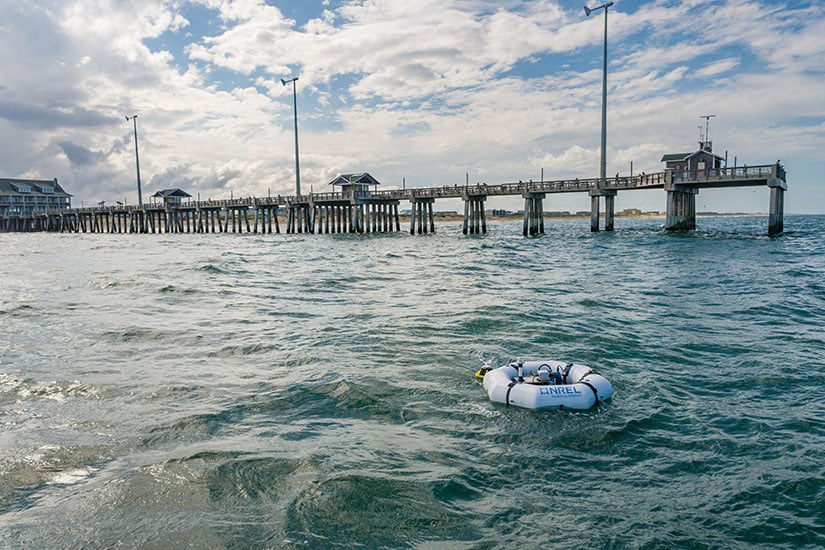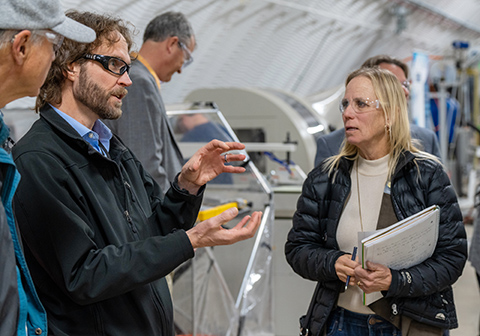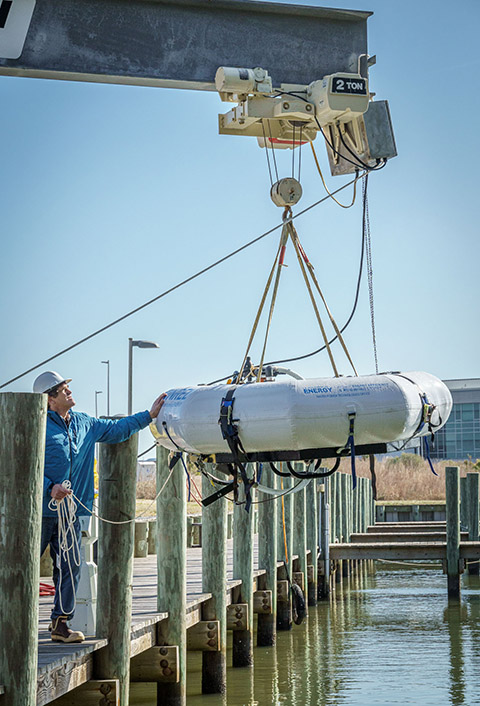Updated Risk Management Framework Supports Success of Marine Energy Devices
 NREL's hydraulic and electric reverse osmosis (HERO) wave energy converter (WEC) is seen anchored off Jennette's Pier in Nags Head, North Carolina. This is NREL’s first marine-powered desalination device to weather ocean waters. Photo by John McCord / Coastal Studies Institute
NREL's hydraulic and electric reverse osmosis (HERO) wave energy converter (WEC) is seen anchored off Jennette's Pier in Nags Head, North Carolina. This is NREL’s first marine-powered desalination device to weather ocean waters. Photo by John McCord / Coastal Studies InstituteThe life of a wave energy converter (WEC) may sound idyllic—bobbing on ocean waves all day or swaying underwater, quietly generating electricity for the people living and working near shore.
But in reality, it takes a lot of careful planning for salt water and electronics to achieve that perceived state of bliss. And that is where a robust risk management plan can find ways to make that pairing work.
The National Renewable Energy Laboratory’s (NREL’s) Marine Energy Technology Development Risk Management Framework gives marine energy researchers and developers a comprehensive process to break down their approach and any variables that may impede or accelerate their success. The tool includes technical components, environmental conditions, funding sources, staffing, stakeholder support, deployment permits, and more.
With a greater understanding of each factor and its underlying components, the framework enables groups to better manage uncertainties (both positive and negative) and develop effective contingency plans.
“You might have one little vulnerable part that costs 10 cents to buy, like an O-ring, but the effects of it failing might be a $1 million loss because it leads to water entering a sealed chamber,” said David Snowberg, NREL engineer and lead author on the report. “That kind of information is useful to know early on.”
Calculating the Odds
The revised framework includes a new template for assessing failure modes, their effects, and their potential causes, which are prioritized through a criticality analysis. This free, public tool can help organizations prioritize their investments while minimizing potential damage and costs.

“A risk register provides a structured approach for managing all sources of uncertainty that might impact your objectives,” Snowberg added. “That uncertainty can also be opportunities where potential unknowns become benefits to your project. A risk register can help you manage both those positive and negative uncertainties.”
He emphasized that it is critical to consider more than just the technical components of a project. Human aspects, such as stakeholder support, are equally important factors in the overall success and timeline of a project.
“Ignoring risks is rarely a good approach,” said Scott Jenne, NREL 's marine energy desalination lead. “They usually come back and cause greater problems than if you had dealt with them early on.”
Using the marine energy risk management framework, people can identify risks, analyze them, and then plan a response. This cycle continues throughout the course of a project so that groups have a responsive, adaptable way to monitor and manage any type of uncertainty that they encounter.
Putting It Into Practice
At NREL, Snowberg is working through the framework with Jenne and the team that designed and built the hydraulic and electric reverse osmosis WEC (HERO WEC), a wave-powered desalination device that has gone through extensive laboratory testing and five ocean installations in North Carolina’s Outer Banks.
“The HERO WEC is able to desalinate seawater using either the hydraulic configuration or the electric configuration—so it has two different energy conversion systems that can be swapped out based on the specific area of research the team is focusing on, which makes it at least twice as complicated as it would be otherwise,” Snowberg said.
Having worked through multiple designs since 2020, Jenne noted, “The complexity increases due to the need to integrate two unique conversion systems on the same device and the fact that you’ve added more things that depend on each other.”

For a device like the HERO WEC, it is not just about basic functionality—survivability is also a key priority. What would it need to survive a 1-in-50-year storm? And what types of conditions would that storm create, from waves and winds to currents and surf?
“The marine environment is harsh,” Snowberg said. “Getting things to survive the corrosion, the biofouling, and everything out there is challenging.”
The HERO WEC team is currently redesigning the second version of the device and leveraging the risk management framework throughout their process—helping them apply lessons learned to build on past successes and steer clear of previous challenges.
“It’s really important that we design HERO WEC to be highly survivable and reliable,” Jenne said. “Having this framework is a critical tool for us to be able to evaluate what might go wrong before we build another physical model.”
Since the development of the original framework 10 years ago, the U.S. Department of Energy’s Water Power Technologies Office has worked closely with NREL to incorporate key components and uphold specific requirements for projects with open water testing that they support.
Snowberg emphasized that the risk management processes are tools for success, meant to meet people where they are at and provide guidance at any stage of project development.
“If you can manage the uncertainty of your project in a way that you see those benefits, then it’s something you’ll be motivated to continue doing,” Snowberg said. “I’ve been at NREL for 15 years, and managing risks to help support marine energy has been the most fulfilling and rewarding type of project that I’ve worked on because it has the most tangible impact.”
With these concrete tools in hand, WPTO and NREL can help pave the way for the marine energy industry to find clearer, quicker paths to success.
Co-authors on the Marine Energy Technology Development Risk Management Framework include Ritu Treisa Philip, NREL mechanical engineer, and Jochem Weber, chief engineer of NREL's Water Power program.
Last Updated May 28, 2025
